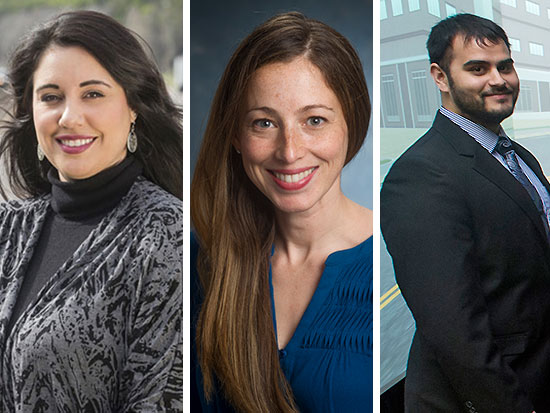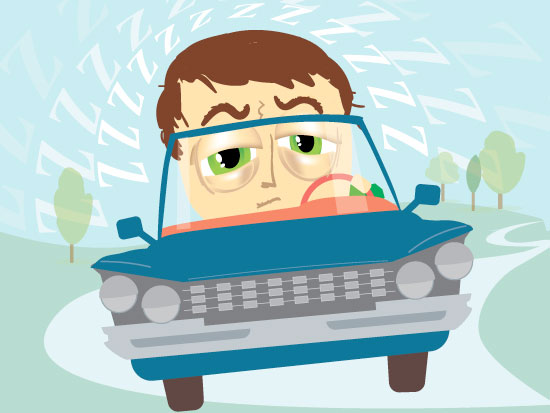 From left: Despina Stavrinos, Jessica Mirman and Benjamin McManusSix teens ages 16 to 19 are killed every day from motor vehicle injuries, according to the Centers for Disease Control and Prevention. National Teen Driver Safety Week is Oct. 21-27, and several experts from the University of Alabama at Birmingham have tips to keep teens safe as they hit the road, including how to decrease passenger distractions and avoiding the risks of texting while driving and drowsy driving.
From left: Despina Stavrinos, Jessica Mirman and Benjamin McManusSix teens ages 16 to 19 are killed every day from motor vehicle injuries, according to the Centers for Disease Control and Prevention. National Teen Driver Safety Week is Oct. 21-27, and several experts from the University of Alabama at Birmingham have tips to keep teens safe as they hit the road, including how to decrease passenger distractions and avoiding the risks of texting while driving and drowsy driving.
“Teens are the most at-risk population on the road,” said Despina Stavrinos, Ph.D., associate professor in the UAB Department of Psychology and director of the UAB Translational Research for Injury Prevention. “We need to prepare them for each circumstance that could arise, while providing them with practical knowledge and tools to safely navigate the roads.”
Passenger distractions
Driving with same-aged passengers can increase teen drivers’ risk for a fatal crash through distraction and intentional risk-taking. However, teen passengers can also be helpful by keeping the driver focused on the road.
“Parents should have conversations with their teens on the risks and benefits of having friends in the car,” said Jessica Mirman, Ph.D., assistant professor in the UAB College of Arts and Sciences. “It is important for parents to set expectations for young drivers before they are riding and driving.”
Mirman has a few recommendations for what passengers can do in order to help drivers keep their hands on the wheel and eyes on the road.
- Respond to text messages
- Take charge of the music
- Notice speed limit changes
- Limit talking and distractions while on the road
- Know the state laws for passenger restrictions
Several states have passenger restrictions of not having more than one non-family passenger other than the parent, guardian or supervising licensed driver at least 21 years of age for the first six months that the teen is licensed.
Passenger restrictions are about safety — not about controlling teens’ personal lives,” Mirman said. “Parents should have household expectations that are in alignment with state laws and not allow their teen to drive with newly licensed drivers, or to drive more teen passengers than are permitted by state law.”
 In 2016, 15 percent of drivers ages 15 to 20 involved in fatal motor vehicle crashes had a blood alcohol concentration of .08 percent or higher, according to the CDC.
In 2016, 15 percent of drivers ages 15 to 20 involved in fatal motor vehicle crashes had a blood alcohol concentration of .08 percent or higher, according to the CDC.
“Don’t let a friend drive or ride impaired, and do not get in a car with an impaired driver,” Mirman said. “Parents should make sure their teen knows it is always OK for the teen to call or text a parent or another trusted adult for a safe ride home no matter what.”
Texting while driving
Each day in the United States, approximately nine people are killed and more than 1,000 are injured in crashes that are reported to involve a distracted driver, according to the U.S. Department of Transportation National Center for Statistics and Analytics .
“We call texting while driving the perfect storm, especially for teens, as it takes your eyes off the road, your hands off the wheel and your mind off of concentrating on what you should be doing — which is driving,” Stavrinos said. “But it’s not just texting that can be an issue. Checking email, interacting through social media or accessing a map program while driving can also be distracting and dangerous.”
Teen drivers are new to the road and still learning the pertinent skills to driving safely. Stavrinos advises that, while driving or doing any task that requires full concentration, one should put the phone far enough away to not be tempted to pick it up at the first ding.
“These are very valuable tools, and we’re not going to give them up,” she said. “But we have to balance the benefits of staying connected while mitigating the impact of the distractions, whether it’s while driving, walking down the street or even having dinner in a restaurant.”
Stavrinos says a little self-control is called for because our love for devices is not going away, nor should it.
 Drowsy driving
Drowsy driving
At least seven hours of sleep is recommended for safe driving, with the odds of a motor vehicle crash increasing for every hour under seven hours of sleep, according to the AAA Foundation for Traffic Safety.
“Many teens are unable to obtain the proper amount of sleep due to combinations of extracurricular activities, homework and school start times,” said Benjamin McManus, Ph.D., assistant director of the UAB TRIPLab. “This is compounded by a natural shift in biological sleep patterns that occurs in the teen years and leads to naturally falling asleep later, yet still needing to wake early.”
People often assume that consuming plenty of caffeine before you start driving will counteract drowsiness. In sleep-deprived individuals, caffeine may speed up reaction time, but at the cost of an increase in errors and poor judgment, resulting in a “fast and sloppy” decision-making process — not ideal for driving.
“Caffeine may improve one’s perception of alertness; but if someone is already sleep-deprived, caffeine may only make things worse,” McManus said. “If you’re driving drowsy, the best solution is to stop driving and take a nap if possible. Even short, 20-minute naps have shown to have restorative qualities.”
The only real, effective countermeasure to sleepiness is sleep. Emphasis must be made on attempting to achieve at least seven hours of good, quality sleep. In order to achieve the level of good, quality sleep to fully function, one should avoid electronics near bedtime or use “night shift” modes that reduce or eliminate the blue spectrum light waves that the brain associates with daytime.